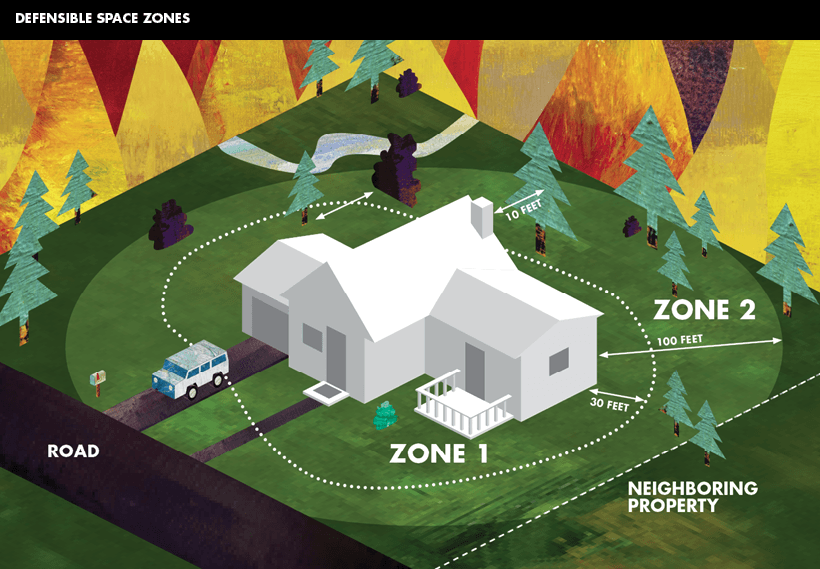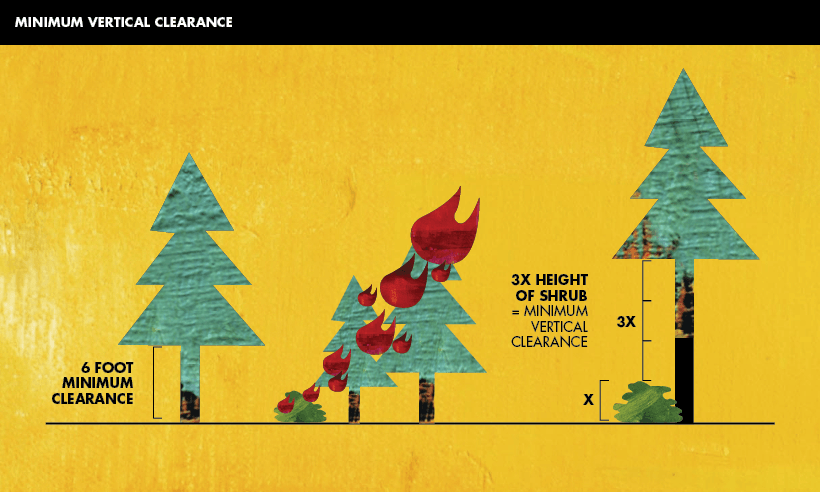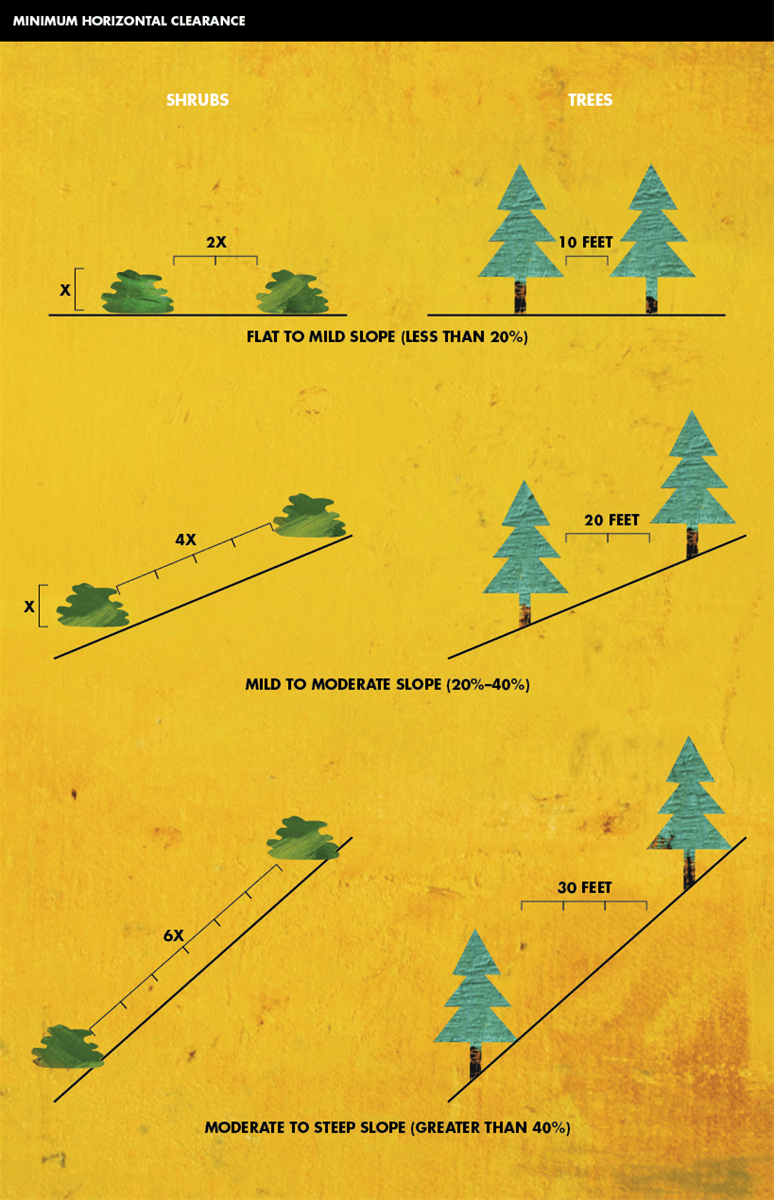Wildfires are a common hazard across California. When conditions are right, small fires can become raging firestorms in the blink of an eye. Being prepared can make all the difference to your safety.
Current Code to Address Wildfire Risk
Residents are required to maintain their properties in good condition at all times, as to alleviate the risk of wildfires. According to Riverside Municipal Code Chapter 6.15 and Title 13, outdoor areas on private property must be kept free of public nuisances. This includes addressing issues such as overgrown vegetation, accumulated debris, or other materials that may pose a risk to health, safety, or the community’s appearance.
Download our Wildfire Preparedness Sheet here
Download our Wildfire Prevention Sheet here

Preparing Your Home for Wildfire
- Always have at least 2 ways to put out a fire during any activity that could start a fire (camp fire, target shooting, mowing, driving in dry areas, etc.). A fire extinguisher, bucket of water, and shovel can all be used.
- Have an evacuation plan and practice it! Know at least two ways to get out, if possible.
- Have multiple ways to get an evacuation alert, even if your power goes out (e.g. phone, email, local emergency alerting system, NOAA Weather Radios)
- Conduct an annual inventory of your personal property. Utilize this helpful Home Inventory Guide from the California Department of Insurance to gather your insurance information.
Know the Terms
- Fire Weather Watch – A Fire Weather Watch is issued in anticipation of Red Flag Warning conditions beyond the first 12-hour forecasting period. It is upgraded to a Red Flag Warning once conditions are 12 hours or less in the future, or the forecast changes and the watch is cancelled.
- Red Flag Warning – A Red Flag Warning means warm temperatures, very low humidities, and stronger winds are expected to combine to produce an increased risk of fire danger.
- Extreme Red Flag Warning – An Extreme Red Flag Warning is issued when conditions are dangerous enough that enhanced wording is needed to convey the danger present. It is analogous to wording added to severe weather watches and warnings, including use of the phrase “This is a Particularly Dangerous Situation.”
- Evacuation Warning – An Evacuation Warning is issued by Public Safety officials to warn of the potential need for an evacuation due to wildfire. This term replaces the Voluntary Evacuation terminology. If you are under an evacuation warning, be ready to go at a moment’s notice, and consider evacuating early if you feel there is danger or need extra time to move to safety. Make sure you have multiple ways to receive alerts, including if power goes out. NOAA Weather Radios are a great tool, in addition to signing up for local Mass Notification alerts like RiversideAlert.
- Evacuation Order – An Evacuation Order replaced the Mandatory Evacuation terminology. This order indicates imminent danger to life and property, even if it is not readily apparent, and you should leave immediately if you are in this area. Remember, things are replaceable. You are not.
Harden Your Home Against Wildfires
- Your Roof
- Wood and shingles are vulnerable to fire. Consider composition, metal, or tile materials instead.
- Make sure you block any spaces between roof decking and coverings to prevent embers from catching.
- Cover your chimney and stovepipe outlets with a non-combustible screen with openings between 3/8-inch and 1/2-inch to prevent embers from escaping and starting a fire.
- Vents
- Cover all vents with 1/8- to 1/4-inch metal mesh. Avoid fiberglass & plastic mesh that can melt or burn.
- Protect vents in eaves and cornices with baffles to block embers (mesh is not enough!)
- Eaves & Soffits
- Protect eaves and soffits with ignition-resistant or non-combustible materials.
- Windows
- Install dual-pane windows that have one pane of tempered glass to prevent embers from getting through broken windows.
- Try to limit size and number of windows facing large areas of vegetation.
- Walls
- Build or remodel exterior walls with ignition-resistant materials, such as metal, brick, stone, or stucco. Wood siding call also be treated with flame retardant sprays but be aware of entry points around joints that need to be protected with trim or other materials as well.
- Make sure material is all the way around, foundation-to-roof.
- Investigate exterior fire-suppression systems.
- Decks, Gutters, & Patios
- Surfaces within 10 feet of the building should be built with ignition-resistant materials.
- Remove combustible items from beneath decks.
- Screen or enclose rain gutters to prevent plant debris.
- Use similar ignition-resistant materials for any patio coverings as you would your roof.
- Garage
- Install weather stripping around and under the garage door.
- Store combustible and flammable liquids away from ignition sources.
- Fences, Driveways, & Access Roads
- Use ignition-resistant fence materials to protect your home from a wildfire.
- Maintain driveways and access roads in accordance with state and local codes.
- Consider maintaining access roads wide enough to accommodate two-way traffic, with a 10-foot clearance on either side.
- Check that all gates open inward, can accommodate emergency vehicles, and trees and shrubs are trimmed back to allow emergency vehicles to pass.
- Make sure you address is clearly visible from the road.
Have the Tools You May Need
- Have enough Garden hoses and ensure they can reach all structures on your property.
- Keep Fire Tools and an Extinguisher handy (e.g. Shovels, buckets, rakes, and saws), such as in your garage.
- Have a ladder that can reach your roof.
Maintain Your Home’s Defensible Space
- Use Fire-resistant Landscaping. This can also help conserve water and raise your property value!
- Have multiple garden hoses that can reach all areas of your home and all structures on your property.
- If you have a pool and/or well, consider getting a pump.
- Maintain a 2-zone space 100-feet around your house and buildings.

- Zone 1 should extend 30 feet from any building, structure, deck, etc. In Zone 1, you should:
- Remove all dead vegetation (Grass, plants, trees, leaves/needles, etc.)
- Trim trees to a minimum or 10 feet from other trees.
- Clear any branches hanging over your roof, and dead branches 10 feet from the chimney.
- Clear gutters and roof of all plant material regularly.
- Remove or prune flammable plants or shrubs near windows.
- Remove all vegetation and items that could catch fire from under decks.
- Separate plants and trees from items that could catch fire, such as patio furniture.
- Move all wood piles to Zone 2.
- Zone 2 should extend 100 feet from any building, structure, deck, etc. In Zone 2, you should:
- Cut or mow annual grass to a maximum of 4 inches.
- Maintain horizontal and vertical clearance between grass, shrubs, and trees (See larger diagrams below at readyforwildfire.org/prepare-for-wildfire/get-ready/defensible-space).
- Remove fallen plant material (leaves, cones, bark, twigs, branches, etc.)


Prevention
While preparedness is important, prevention can make a huge difference too. Up to 90% of fires are started by human activity. Doing your part to prevent wildfires can mean more firefighting resources can be committed to each fire, which means more homes saved.
Using Outdoor Equipment Properly
- Ensure equipment is used properly, and in proper working order. Be aware of spark potentials (e.g. Mower blades striking rocks, overheating motor, etc.).
Be Prepared to Put Out a Small Fire
- Have at least two ways to put out a fire while doing anything that could result in a fire (Driving, Mowing, etc.).
- Know who to call if a fire starts and cannot be controlled quickly.
Maintaining Your Property
- Mow regularly.
- Create a defensible space around homes near wildland areas.
- Make sure fire trucks can get to your house and outbuildings in an emergency.
- Regularly inspect your chimney, and make sure it has a spark screen that is in good working condition.
- Stack Firewood at least 100 feet away from your home, preferable uphill.
Operate and Maintain Your Vehicles Safely
- Avoid driving on dry grass or brush. Exhaust systems are hot enough to start fires!
- Secure chains and other dragging parts that could cause sparks.
- Maintain brakes and tire pressure. Thin brake pads and driving on rims can cause sparks!
Follow Safe Fire Habits
- Observe burn bans announced my local governments.
- Remember: There is no recreational or debris burning within Riverside city limits.
- Avoid burning debris outdoors during windy days or when surrounding vegetation is dry.
- NEVER leave a fire unattended. By law, a responsible adult must attend a fire until it is out.
- Soak grill for fireplace ashes in water for a day before disposing of them.
- Keep landscape burn piles smaller than 4 feet by 4 feet and clear all flammable materials and vegetation within 10 feet of the outer edge of the pile.
- Burn only on Permissive Burn Days according to your local air district with a valid Burn Permit.
Camp Safely
- Obtain campfire permits for any campfire or portable gas stove on public lands.
- Completely extinguish a fire: Drown the fire with water, stir the site to ensure all embers are wetted, and feel the area with the back of your hand to make sure nothing is still smoldering.
Learn more at https://www.readyforwildfire.org/.
Current Code to Address Wildfire Risk
Residents are required to maintain their properties in good condition at all times, as to alleviate the risk of wildfires. According to Riverside Municipal Code Chapter 6.15 and Title 13, outdoor areas on private property must be kept free of public nuisances. This includes addressing issues such as overgrown vegetation, accumulated debris, or other materials that may pose a risk to health, safety, or the community’s appearance.
